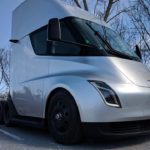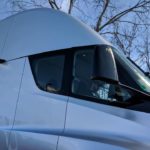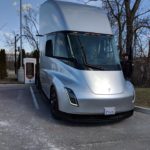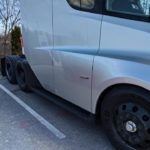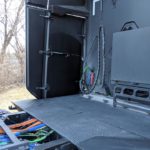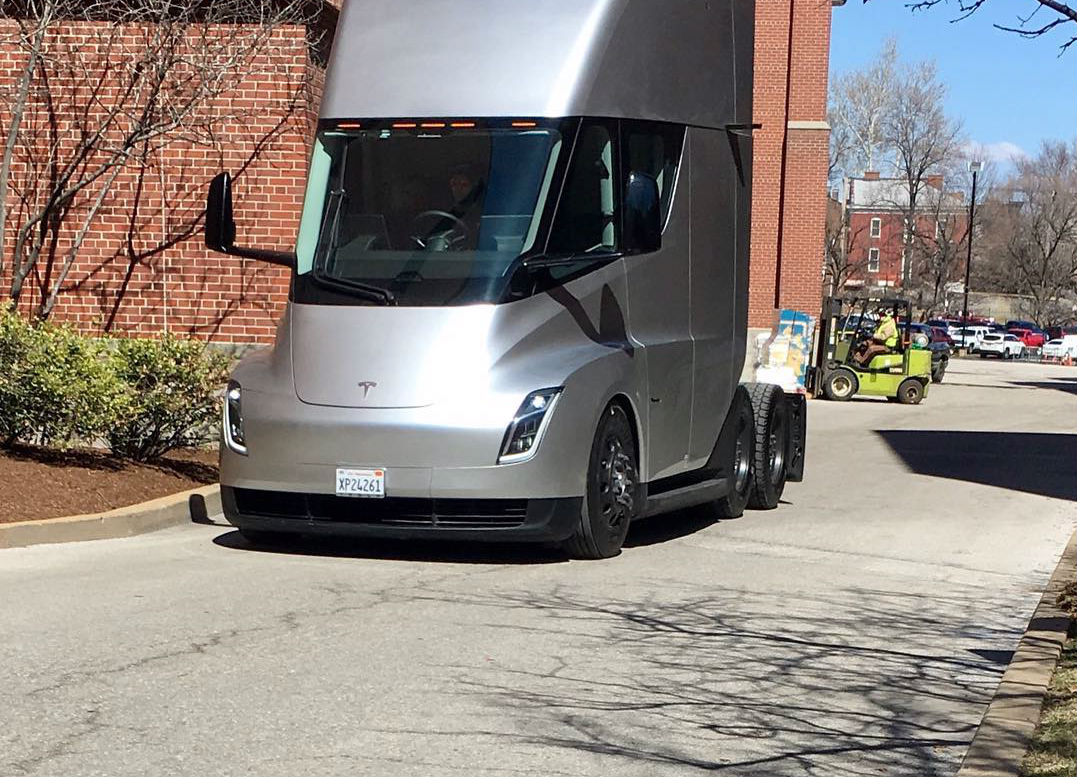
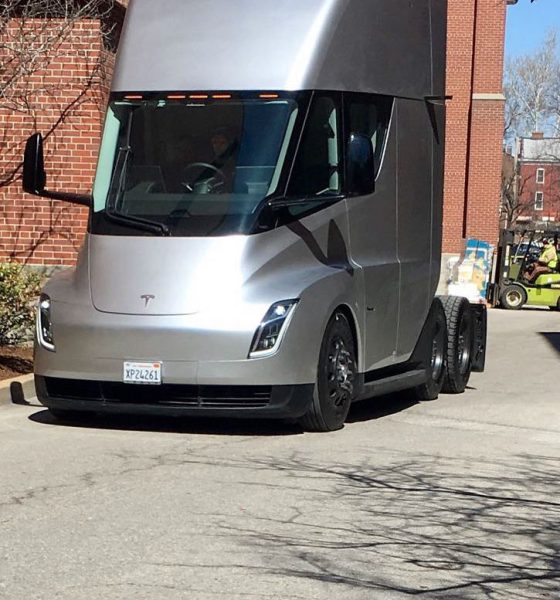
News
Tesla Semi spotted at customer Anheuser-Busch’s facility in St. Louis, MO
The long-range Tesla Semi that was spotted doing delivery runs between the Fremont factory and Gigafactory 1 in Nevada has been sighted more than 2,000 miles away at the Anheuser-Busch brewery in St. Louis, MO on Tuesday. The massive electric long-hauler was also seen parked at the St. Charles, MO Supercharger, roughly 24 miles away from the beer giant’s facility, later in the day.
Reports of the Tesla Semi’s visit to the Anheuser-Busch brewery in St. Louis started emerging after pictures of the electric truck parked in the facility made their rounds in social media. Baron Rana, a member of the St. Louis Tesla Enthusiasts Facebook Group, shared images of the Tesla Semi parked beside the brewery’s brick walls. Dan Mueller, another Tesla enthusiast in the area, also managed to photograph the electric truck as he was attending a tour of the Anheuser-Busch facility.
The reasons behind the truck’s visit to the beer giant’s St. Louis brewery remains unknown, though it is possible that Tesla is looking into testing the Semi’s high-powered chargers that are being installed in some of its clients’ facilities. As we mentioned in a previous report, Tesla is currently working with some of its biggest Semi buyers such as PepsiCo, UPS, and Anheuser-Busch, to build on-site charging stations for the electric long-haulers.
The chargers, presumably Tesla’s high-powered Megachargers, are set to be installed at key locations frequently visited by fleet operators. This system would enable the Semi to travel from one facility to another without compromising its range. With this in mind, the Anheuser-Busch facility in St. Louis definitely seems to be a site where the beer giant could build a charging stations for the 40 Tesla Semis that the company ordered.
As it turned out, Tuesday was not just a day of Tesla Semi sightings at the Anheuser-Busch St. Louis brewery. A few hours after the St. Louis sighting, one member of the St. Louis Tesla Enthusiasts Facebook Group, Kyle Feller, was able to locate the truck parked at the St. Charles Supercharger, and he was able to get some highly-detailed close-ups of the electric long-hauler. Here are the pictures taken by Feller, who was fortunate enough to capture what could very well be the closest look at the Tesla Semi’s details to date.
- The Tesla Semi parked at the St. Charles, MO Supercharger. [Credit: Kyle Feller via Facebook]
- The Tesla Semi parked at the St. Charles, MO Supercharger. [Credit: Kyle Feller via Facebook]
- The Tesla Semi parked at the St. Charles, MO Supercharger. [Credit: Kyle Feller via Facebook]
- The Tesla Semi parked at the St. Charles, MO Supercharger. [Credit: Kyle Feller via Facebook]
- The Tesla Semi parked at the St. Charles, MO Supercharger. [Credit: Kyle Feller via Facebook]
As we mentioned in a previous report, the Tesla’s two Semi prototypes were recently sighted at a Supercharger in Rocklin, located near Sacramento, CA. The two electric trucks were extensively photographed and filmed then, with Model S owner Eli Burton of YouTube’s My Tesla Adventure channel tailing the two electric trucks as they headed into I-80 on a westward route towards the Bay Area. As could be seen in the footage that Burton captured, the Semis boast some insane acceleration and torque, allowing the massive vehicles to accelerate nimbly despite pulling trailers behind.

News
Tesla FSD v14.2.2 is getting rave reviews from drivers
So far, early testers have reported buttery-smooth drives with confident performance, even at night or on twisty roads.

Tesla Full Self-Driving (Supervised) v14.2.2 is receiving positive reviews from owners, with several drivers praising the build’s lack of hesitation during lane changes and its smoother decision-making, among others.
The update, which started rolling out on Monday, also adds features like dynamic arrival pin adjustment. So far, early testers have reported buttery-smooth drives with confident performance, even at night or on twisty roads.
Owners highlight major improvements
Longtime Tesla owner and FSD user @BLKMDL3 shared a detailed 10-hour impression of FSD v14.2.2, noting that the system exhibited “zero lane change hesitation” and “extremely refined” lane choices. He praised Mad Max mode’s performance, stellar parking in locations including ticket dispensers, and impressive canyon runs even in dark conditions.
Fellow FSD user Dan Burkland reported an hour of FSD v14.2.2’s nighttime driving with “zero hesitations” and “buttery smooth” confidence reminiscent of Robotaxi rides in areas such as Austin, Texas. Veteran FSD user Whole Mars Catalog also demonstrated voice navigation via Grok, while Tesla owner Devin Olsen completed a nearly two-hour drive with FSD v14.2.2 in heavy traffic and rain with strong performance.
Closer to unsupervised
FSD has been receiving rave reviews, even from Tesla’s competitors. Xpeng CEO He Xiaopeng, for one, offered fresh praise for FSD v14.2 after visiting Silicon Valley. Following extended test drives of Tesla vehicles running the latest FSD software, He stated that the system has made major strides, reinforcing his view that Tesla’s approach to autonomy is indeed the proper path towards autonomy.
According to He, Tesla’s FSD has evolved from a smooth Level 2 advanced driver assistance system into what he described as a “near-Level 4” experience in terms of capabilities. While acknowledging that areas of improvement are still present, the Xpeng CEO stated that FSD’s current iteration significantly surpasses last year’s capabilities. He also reiterated his belief that Tesla’s strategy of using the same autonomous software and hardware architecture across private vehicles and robotaxis is the right long-term approach, as it would allow users to bypass intermediate autonomy stages and move closer to Level 4 functionality.
News
Elon Musk’s Grok AI to be used in U.S. War Department’s bespoke AI platform
The partnership aims to provide advanced capabilities to 3 million military and civilian personnel.

The U.S. Department of War announced Monday an agreement with Elon Musk’s xAI to embed the company’s frontier artificial intelligence systems, powered by the Grok family of models, into the department’s bespoke AI platform GenAI.mil.
The partnership aims to provide advanced capabilities to 3 million military and civilian personnel, with initial deployment targeted for early 2026 at Impact Level 5 (IL5) for secure handling of Controlled Unclassified Information.
xAI Integration
As noted by the War Department’s press release, GenAI.mil, its bespoke AI platform, will gain xAI for the Government’s suite of tools, which enable real-time global insights from the X platform for “decisive information advantage.” The rollout builds on xAI’s July launch of products for U.S. government customers, including federal, state, local, and national security use cases.
“Targeted for initial deployment in early 2026, this integration will allow all military and civilian personnel to use xAI’s capabilities at Impact Level 5 (IL5), enabling the secure handling of Controlled Unclassified Information (CUI) in daily workflows. Users will also gain access to real‑time global insights from the X platform, providing War Department personnel with a decisive information advantage,” the Department of War wrote in a press release.
Strategic advantages
The deal marks another step in the Department of War’s efforts to use cutting-edge AI in its operations. xAI, for its part, highlighted that its tools can support administrative tasks at the federal, state and local levels, as well as “critical mission use cases” at the front line of military operations.
“The War Department will continue scaling an AI ecosystem built for speed, security, and decision superiority. Newly IL5-certified capabilities will empower every aspect of the Department’s workforce, turning AI into a daily operational asset. This announcement marks another milestone in America’s AI revolution, and the War Department is driving that momentum forward,” the War Department noted.
News
Tesla FSD (Supervised) v14.2.2 starts rolling out
The update focuses on smoother real-world performance, better obstacle awareness, and precise end-of-trip routing, among other improvements.

Tesla has started rolling out Full Self-Driving (Supervised) v14.2.2, bringing further refinements to its most advanced driver-assist system. The new FSD update focuses on smoother real-world performance, better obstacle awareness, and precise end-of-trip routing, among other improvements.
Key FSD v14.2.2 improvements
As noted by Not a Tesla App, FSD v14.2.2 upgrades the vision encoder neural network with higher resolution features, enhancing detection of emergency vehicles, road obstacles, and human gestures. New Arrival Options let users select preferred drop-off styles, such as Parking Lot, Street, Driveway, Parking Garage, or Curbside, with the navigation pin automatically adjusting to the user’s ideal spot for precision.
Other additions include pulling over for emergency vehicles, real-time vision-based detours for blocked roads, improved gate and debris handling, and extreme Speed Profiles for customized driving styles. Reliability gains cover fault recovery, residue alerts on the windshield, and automatic narrow-field camera washing for new 2026 Model Y units.
FSD v14.2.2 also boosts unprotected turns, lane changes, cut-ins, and school bus scenarios, among other things. Tesla also noted that users’ FSD statistics will be saved under Controls > Autopilot, which should help drivers easily view how much they are using FSD in their daily drives.
Key FSD v14.2.2 release notes
Full Self-Driving (Supervised) v14.2.2 includes:
- Upgraded the neural network vision encoder, leveraging higher resolution features to further improve scenarios like handling emergency vehicles, obstacles on the road, and human gestures.
- Added Arrival Options for you to select where FSD should park: in a Parking Lot, on the Street, in a Driveway, in a Parking Garage, or at the Curbside.
- Added handling to pull over or yield for emergency vehicles (e.g. police cars, fire trucks, ambulances).
- Added navigation and routing into the vision-based neural network for real-time handling of blocked roads and detours.
- Added additional Speed Profile to further customize driving style preference.
- Improved handling for static and dynamic gates.
- Improved offsetting for road debris (e.g. tires, tree branches, boxes).
- Improve handling of several scenarios, including unprotected turns, lane changes, vehicle cut-ins, and school buses.
- Improved FSD’s ability to manage system faults and recover smoothly from degraded operation for enhanced reliability.
- Added alerting for residue build-up on interior windshield that may impact front camera visibility. If affected, visit Service for cleaning!
- Added automatic narrow field washing to provide rapid and efficient front camera self-cleaning, and optimize aerodynamics wash at higher vehicle speed.
- Camera visibility can lead to increased attention monitoring sensitivity.
Upcoming Improvements:
- Overall smoothness and sentience.
- Parking spot selection and parking quality.
